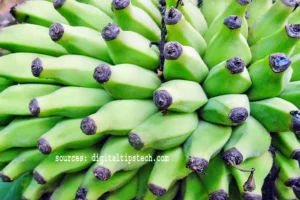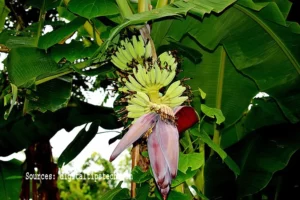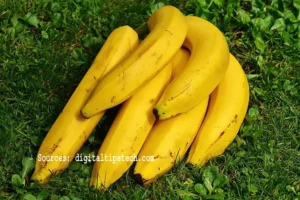Harvesting bananas requires some care and attention to ensure you pick the fruit at the right time and avoid damaging the plant. Here’s a step-by-step guide on how to harvest bananas:
Identify the right time to harvest:
Bananas should be harvested when they are fully mature and have reached their appropriate size and color. The exact time will depend on the banana variety, but generally, bananas are ready to harvest when they are mostly yellow with a slight green tinge.

Examine the hands and fingers:
A banana bunch is made up of several “hands,” and each hand contains multiple “fingers.” Wait until the bananas are well-rounded, fully developed, and have filled out the hand entirely. The individual bananas on the hand should be plump and not too angular.
Observe the color:
The skin of the bananas should be mostly yellow. While some green is acceptable, too much green indicates that the fruit is not yet ripe. Conversely, if the bananas have turned fully yellow, they are likely overripe.
Check for starchiness:
If possible, you can perform a starch test to determine the maturity of the bananas. Cut a small section from the tip of one of the fruits and apply iodine to the cut area. If the iodine remains brown, the bananas are still starchy and not ready for harvest. If it turns blue, the bananas are ripe and ready to be harvested.
Use proper harvesting tools:
To avoid damaging the plant and the fruit, use a sharp knife or a machete with a clean, smooth blade. Avoid using blunt or serrated knives as they may cause unnecessary damage.
Cut the bunch carefully:
Stand on a stable platform or ladder to reach the bunch comfortably. Cut the bunch with a slight upward angle, leaving a small portion of the stem attached to the bananas. Be careful not to damage the nearby suckers or the main plant.
Lower the bunch carefully:
Lower the harvested bunch gently to the ground using a rope or by hand if the bunch is small and manageable. Avoid dropping it from a height as this can bruise the fruit.
Trim the plant:
After harvesting, trim the plant’s leaves that have turned yellow or have become damaged. This will help the plant focus its energy on the development of new fruit.
Transport and storage:
Handle the bananas with care during transportation to avoid bruising. To extend their shelf life, store them in a cool, dry environment.

Remember that banana plants produce multiple hands over time, so you can harvest them in batches as they ripen. Proper harvesting techniques will not only give you delicious bananas but also help the plant remain healthy and productive.
How do you cut down a banana bunch?
To cut down a banana bunch, you will need a few tools and follow a step-by-step process. Here’s a general guideline:
Gather the necessary tools:
You will need a sharp machete or a large knife, a ladder or a stable platform, and a pair of gloves.
Assess the bunch:
Look at the bunch and identify the mature fruit that is ready for harvesting. The bananas should be plump, slightly rounded, and have a bright yellow color.
Set up a stable platform:
Place a ladder or a stable platform beneath the bunch to reach it easily and safely. Make sure the ladder is securely positioned and won’t wobble.
Put on gloves:
Wear a pair of protective gloves to prevent any injuries while cutting and handling the bunch.
Position yourself safely:
Stand on the ladder or the stable platform at a height where you can comfortably reach the banana bunch. Ensure that you have a secure footing and maintain balance.
Locate the stem:
Look for the main stem that connects the bunch to the banana plant. It will be thicker and stronger than the individual stems of the bananas.
Position the blade:
Hold the machete or knife with a firm grip and position it at an angle against the main stem. It is best if the blade is pointed away from you.
Make the cut:
Swing the machete or knife in a downward motion, using controlled force, to sever the bunch from the main stem. Be cautious and ensure your body parts are clear from the blade’s path.
Lower the bunch gently:
Once the cut is made, carefully lower the bunch to the ground or onto a soft surface to prevent damage to the fruit.
Clean up: Remove any excess foliage or trim the remaining stem from the banana plant if necessary.
How many times banana is harvested?
Bananas typically undergo a single harvest per plant, after which the entire plant is cut down. However, the term “harvest” can also refer to the removal of individual bunches of bananas from the plant during the growing season. Each banana plant usually produces one main bunch or “hand” of bananas, which consists of multiple individual bananas. Once the main bunch is harvested, new shoots may emerge from the base of the plant, eventually developing their own bunches.

This process is known as “suckering” or “ratooning.” These secondary bunches can be harvested separately from the main bunch, but the number of suckers produced and the subsequent harvests can vary depending on the variety of banana, growing conditions, and agricultural practices. In commercial banana plantations, it is common for only the main bunch to be harvested before the plant is cut down to make way for new plants.
How do you ripen bananas off the tree?
To ripen bananas off the tree, you can follow these steps:
Harvest the bananas:
Pick the bananas when they are mature but still green. Make sure to use a sharp knife or shears to cut the bunch from the tree, leaving a portion of the stem attached to the fruit.
Separate the bunch:
If you have harvested a bunch of bananas, separate them carefully to prevent bruising or damage. Individual bananas can be ripened separately.
Remove excess dirt and debris:
Gently brush off any excess dirt or debris from the bananas using your hands or a soft cloth. Avoid washing them as moisture can speed up the ripening process and lead to premature spoilage.
Hang the bananas:
Hang the bananas in a cool, dry place away from direct sunlight. You can use a banana hanger, a sturdy hook, or simply tie a string around the stems and hang them from a hook or rod. Ensure that they are not crowded and have enough space for air circulation.
Monitor the ripening process:
Check the bananas daily to monitor their ripening progress. As bananas ripen, they release a natural gas called ethylene, which speeds up the ripening process. Placing them in a closed paper bag can trap this gas and accelerate ripening. You can place an apple or a ripe banana in the bag along with the green bananas to speed up the process further.
Adjust ripening conditions:
If the bananas are ripening too quickly, you can remove them from the bag or move them to a slightly cooler location to slow down the process. If they are taking too long to ripen, you can move them to a warmer spot.
Check for ripeness:
Once the bananas have reached the desired ripeness, which is typically when they turn yellow with some brown speckles, you can remove them from the hanging position and store them at room temperature or in the refrigerator to slow down further ripening.
What is the harvest maturity of banana?
The harvest maturity of bananas can vary depending on the variety and growing conditions. However, there are some general indicators to determine when bananas are mature and ready for harvest.
Bananas typically reach their harvest maturity when the fruit has filled out completely, achieved its full size, and the starches have converted to sugars. The peel should have a yellow color, though some varieties may have green or reddish hues even when ripe. Here some specific list below:
Color:
The peel should be predominantly yellow. Green bananas are not yet mature, while brown or black bananas are overripe.
Size:
The fruit should have reached its expected size according to the variety. Each variety has its own typical size range.
Texture:
It should have a solid but not overly harsh peel. It ought to slightly give under pressure without becoming mushy.
Taste:
The flesh should be sweet and flavorful. Green bananas are usually starchy and less sweet, while ripe bananas have a sweeter taste.
Final Thought:
Keep in mind that some banana varieties may have specific ripening characteristics, such as plantains that are typically cooked when green and starchy. It’s also worth noting that bananas can be harvested at different stages of ripeness depending on the intended use. For immediate consumption, you might prefer slightly ripened bananas, while bananas intended for longer storage or transportation may be harvested at a more mature stage.